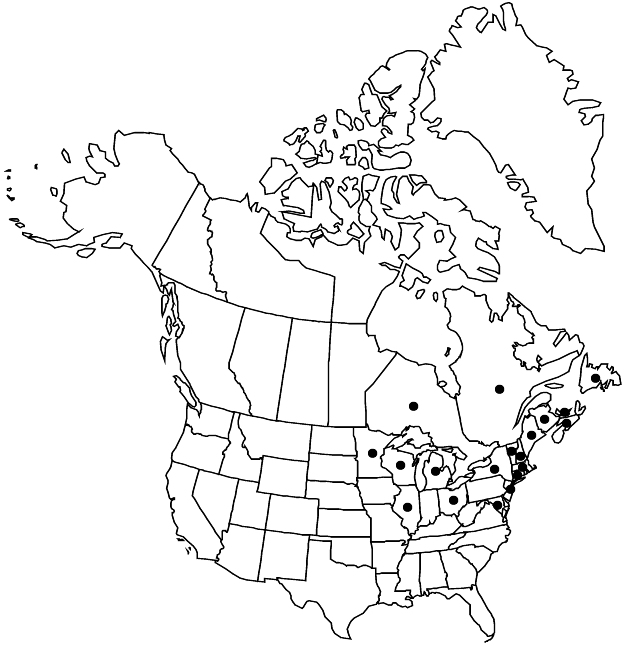Difference between revisions of "Ribes nigrum"
Sp. Pl. 1: 201. 1753 ,.
FNA>Volume Importer |
imported>Volume Importer |
||
| (3 intermediate revisions by 2 users not shown) | |||
| Line 7: | Line 7: | ||
}} | }} | ||
|common_names=Garden black currant;gadellier noir | |common_names=Garden black currant;gadellier noir | ||
| + | |special_status={{Treatment/ID/Special_status | ||
| + | |code=I | ||
| + | |label=Introduced | ||
| + | }} | ||
|basionyms= | |basionyms= | ||
|synonyms= | |synonyms= | ||
| Line 23: | Line 27: | ||
|elevation=100-300 m | |elevation=100-300 m | ||
|distribution=N.B.;Nfld. and Labr. (Nfld.);N.S.;Ont.;P.E.I.;Que.;Conn.;Ill.;Maine;Md.;Mass.;Mich.;Minn.;N.H.;N.J.;N.Y.;Ohio;Vt.;Wis.;Eurasia. | |distribution=N.B.;Nfld. and Labr. (Nfld.);N.S.;Ont.;P.E.I.;Que.;Conn.;Ill.;Maine;Md.;Mass.;Mich.;Minn.;N.H.;N.J.;N.Y.;Ohio;Vt.;Wis.;Eurasia. | ||
| + | |introduced=true | ||
|discussion=<p><i>Ribes nigrum</i> is the source of the cultivated black currant. It has a strong, unpleasant odor.</p> | |discussion=<p><i>Ribes nigrum</i> is the source of the cultivated black currant. It has a strong, unpleasant odor.</p> | ||
|tables= | |tables= | ||
| Line 32: | Line 37: | ||
-->{{#Taxon: | -->{{#Taxon: | ||
name=Ribes nigrum | name=Ribes nigrum | ||
| − | |||
|authority=Linnaeus | |authority=Linnaeus | ||
|rank=species | |rank=species | ||
| Line 47: | Line 51: | ||
|publication title=Sp. Pl. | |publication title=Sp. Pl. | ||
|publication year= | |publication year= | ||
| − | |special status= | + | |special status=Introduced |
| − | |source xml=https:// | + | |source xml=https://bitbucket.org/aafc-mbb/fna-data-curation/src/2e0870ddd59836b60bcf96646a41e87ea5a5943a/coarse_grained_fna_xml/V8/V8_20.xml |
|genus=Ribes | |genus=Ribes | ||
|species=Ribes nigrum | |species=Ribes nigrum | ||
Latest revision as of 23:42, 5 November 2020
Plants 1–2 m. Stems erect, glandular and puberulent or nearly glabrous; spines at nodes absent; prickles on internodes absent. Leaves: petiole 1–4 cm, pubescent, sometimes with longer setose hairs basally; blade reniform, 3–5-lobed, cleft nearly to midrib, 5–10 cm, base cordate, surfaces with shiny, resinous glands, lobes broadly ovate, margins irregularly serrate, apex acute. Inflorescences pendent, 4–10-flowered racemes, 3–5 cm, axis pubescent, flowers evenly spaced. Pedicels jointed, 2–10 mm, glabrous or finely pubescent to lanate; bracts ovate, 0.5–2 mm, pubescent. Flowers: hypanthium green, cup-shaped or short-campanulate, 3–4 mm, densely pubescent or tomentose; sepals not overlapping, reflexed, greenish or pinkish abaxially, suffused with purple adaxially, oblong, 5–7 mm; petals nearly connivent, erect, white to reddish, bluntly deltate, not conspicuously revolute or inrolled, 1.5–3 mm; nectary disc prominent, green or purplish, circular, covering ovary; stamens slightly longer than petals; filaments linear, 2–2.5 mm, glabrous with some glands; anthers white, sagittate, 1 mm, apex blunt; ovary pubescent, sessile-glandular; styles connate nearly to stigmas, 3 mm, very finely hairy. Berries sweet-tasting, black, globose, 12–15 mm, glabrous with some sessile glands.
Phenology: Flowering May–Jun.
Habitat: Wet meadows, disturbed streamsides, anthropogenic habitats
Elevation: 100-300 m
Distribution

Introduced; N.B., Nfld. and Labr. (Nfld.), N.S., Ont., P.E.I., Que., Conn., Ill., Maine, Md., Mass., Mich., Minn., N.H., N.J., N.Y., Ohio, Vt., Wis., Eurasia.
Discussion
Ribes nigrum is the source of the cultivated black currant. It has a strong, unpleasant odor.
Selected References
None.